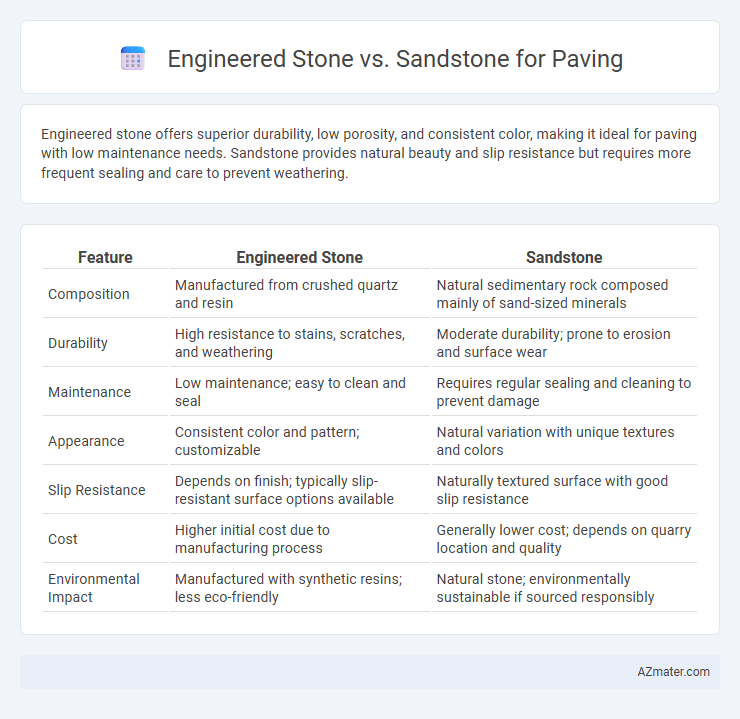Engineered stone offers superior durability, low porosity, and consistent color, making it ideal for paving with low maintenance needs. Sandstone provides natural beauty and slip resistance but requires more frequent sealing and care to prevent weathering.
Table of Comparison
| Feature | Engineered Stone | Sandstone |
|---|---|---|
| Composition | Manufactured from crushed quartz and resin | Natural sedimentary rock composed mainly of sand-sized minerals |
| Durability | High resistance to stains, scratches, and weathering | Moderate durability; prone to erosion and surface wear |
| Maintenance | Low maintenance; easy to clean and seal | Requires regular sealing and cleaning to prevent damage |
| Appearance | Consistent color and pattern; customizable | Natural variation with unique textures and colors |
| Slip Resistance | Depends on finish; typically slip-resistant surface options available | Naturally textured surface with good slip resistance |
| Cost | Higher initial cost due to manufacturing process | Generally lower cost; depends on quarry location and quality |
| Environmental Impact | Manufactured with synthetic resins; less eco-friendly | Natural stone; environmentally sustainable if sourced responsibly |
Introduction to Engineered Stone and Sandstone
Engineered stone is a composite material made from crushed natural stone bound together with resin, offering enhanced durability and uniform appearance for paving. Sandstone, a natural sedimentary rock, is prized for its unique textures and earthy tones but tends to be more porous and softer compared to engineered stone. Both materials provide aesthetic appeal, yet engineered stone delivers greater resistance to wear and environmental stresses, making it ideal for high-traffic paving areas.
Composition and Manufacturing Process
Engineered stone is composed of approximately 90-95% crushed natural quartz combined with resin binders and pigments, resulting in a dense, non-porous surface, while sandstone is a natural sedimentary rock primarily made of sand-sized mineral particles, predominantly quartz and feldspar. The manufacturing process of engineered stone involves mixing raw materials, compressing them under high pressure, and curing with resin to enhance durability and uniformity, whereas sandstone is quarried and cut directly from natural deposits without added processing or binding agents. This difference in composition and fabrication contributes to engineered stone's superior hardness, resistance to staining, and greater consistency compared to the more porous and variable texture of natural sandstone.
Aesthetic Differences and Design Options
Engineered stone offers a consistent color palette and uniform texture, allowing precise design execution with options like intricate patterns and custom shapes, ideal for modern paving projects. Sandstone provides natural variability in color and grain, creating unique, organic aesthetics that enhance traditional or rustic outdoor spaces. The versatility of engineered stone supports bold, repeated geometric designs, while sandstone excels in irregular layouts emphasizing natural beauty.
Durability and Weather Resistance
Engineered stone offers superior durability and weather resistance compared to natural sandstone, featuring enhanced resistance to cracking, chipping, and fading under extreme temperature fluctuations. Its non-porous surface prevents water absorption, reducing the risk of freeze-thaw damage and staining common in sandstone. Sandstone, while aesthetically pleasing with natural variations, requires regular sealing and maintenance to withstand harsh weather conditions and avoid erosion over time.
Installation Requirements and Techniques
Engineered stone demands precise installation techniques, including specialized adhesives like polymer-modified thin-set mortar for strong bonds and careful handling to prevent chipping due to its engineered composition. Sandstone requires a more traditional approach, often set with cement mortar or compacted sand, with attention to its natural porosity and potential for uneven absorption affecting the mortar bond. Both materials benefit from a well-prepared sub-base and correct leveling to ensure durability, but engineered stone's uniform thickness allows for more predictable installation compared to the variability seen in natural sandstone slabs.
Maintenance and Cleaning Considerations
Engineered stone offers superior resistance to stains, scratches, and weathering, making maintenance simpler and less frequent compared to sandstone, which is porous and more susceptible to dirt buildup and damage. Routine cleaning of sandstone requires gentle, pH-neutral cleaners and periodic sealing to prevent erosion and discoloration, while engineered stone often only needs regular sweeping and occasional washing with mild detergent. The durability and low-porosity characteristics of engineered stone significantly reduce long-term cleaning efforts, making it more suitable for high-traffic paving areas.
Environmental Impact and Sustainability
Engineered stone for paving is typically composed of crushed quartz mixed with resin, offering low porosity and high durability that reduces maintenance and replacement frequency, thereby minimizing resource consumption. Sandstone, a natural sedimentary rock, is highly porous and susceptible to weathering, often requiring sealing and more frequent repairs that can increase environmental impact over time. Choosing engineered stone can support sustainability goals through its efficient use of materials and extended lifespan, while sandstone's natural extraction process and shorter durability may lead to higher ecological footprints.
Cost Comparison and Budget Considerations
Engineered stone typically costs between $70 and $100 per square foot, making it a higher initial investment compared to sandstone, which ranges from $15 to $30 per square foot. Despite the higher upfront cost, engineered stone offers greater durability and lower maintenance expenses over time, potentially reducing long-term budget concerns. Sandstone's affordability suits tight budgets but may incur additional costs due to weathering and repairs.
Slip Resistance and Safety Features
Engineered stone offers superior slip resistance compared to natural sandstone due to its consistent surface texture and non-porous composition, reducing water absorption and the risk of slippery conditions. Sandstone's variable grain and porosity can become slippery when wet, posing higher safety concerns in outdoor paving applications. Choosing engineered stone enhances safety by providing a more reliable, slip-resistant surface ideal for high-traffic or wet environments.
Best Applications for Each Material
Engineered stone offers superior durability and resistance to stains, making it ideal for high-traffic commercial paving and modern outdoor spaces requiring low maintenance. Sandstone provides natural slip resistance and aesthetic warmth, suited for garden paths, patios, and historical restoration projects. Choosing between the two depends on factors like environmental exposure, desired texture, and budget constraints.

Infographic: Engineered stone vs Sandstone for Paving
 azmater.com
azmater.com